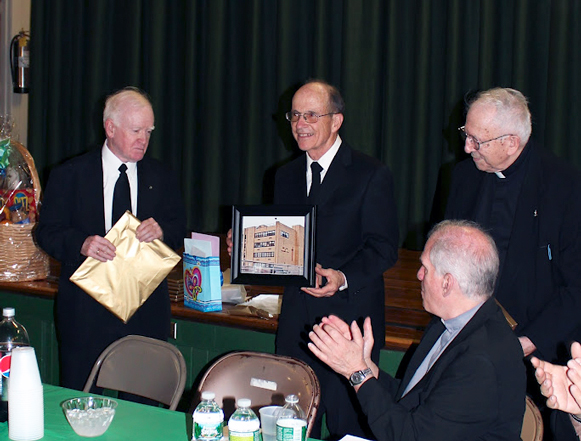
With a Mass of thanksgiving and a celebratory dinner, the Marianist Province of the United States marked a bittersweet occasion on Sunday, May 20. The event marked the 75th year since the community took charge of St. John’s Home for Boys, Rockaway Park, in 1937 at the request of Bishop Thomas E. Molloy.
The celebration of the 75th anniversary also was an occasion to bid farewell to the Marianist Community as it will be withdrawing from its ministry at St. John’s. The advanced age of the Marianists, who have been serving at St. John’s and the lack of viable replacements prompted the Marianist Provincial Council of the United States to request a withdrawal of the five Marianists at the Home.
The event took place at St. Camillus Church, Rockaway Beach, the parish that includes St. John’s. The dinner was held in Springmann Hall, a parish facility named for the late Brother Frank Springmann, S.M. Brother Frank was a former teacher and director of the sports program, as well as the principal at St. John’s School. He was also known for his creation and coordination of the singing group, The Peanuts, which brought the St. John’s boys national attention when they appeared on network television in the 1950s.
The Mass was celebrated by Father Martin Solma, S.M., Provincial of the Province of the United States. Father Paul Landolfi, S.M., one of the St. John’s Community members, gave the homily. Msgr. Alfred LoPinto, Vicar for Human Resources, represented the diocese.
About 250 guests attended, including present and former staff members, residents and members from the Alumni Association from St. John’s, Marianists associates, the local clergy, the Sisters of St. Joseph and friends of St. John’s.
Father Paul Marshall, S.M. presented each of the Brothers of the St. John’s Community with a framed photo of the St. John’s Residence building. Paul “Woody” Garavente, president of the St. John’s board, had words of commendation for Brother Thomas N. Trager, who has served at St. John’s for close to 40 years, 38 of them as executive director. In that position, he has led St. John’s through numerous and sometimes difficult and complex challenges that are reflective of both society in general and those working with youth and families in need.
Founded in 1868 in Brooklyn as an orphanage, St. John’s Home grew to encompass three facilities: the home in the Crown Heights section of Brooklyn, a summer “ocean” home in Coney Island and a farm in Hicksville, L.I. The resident population peaked at more that 1,200 during the early decades of the 20th century. With improved health care and reduced worker mortality, the number of orphans declined, and the population in residence dropped by the late 1930s. The farm in Hicksville closed, and the average age of the boys in residence increased. Consequently, Bishop Molloy sought a community of men to direct the home.
The Marianists answered that call and assumed the responsibilities for St. John’s in the fall of 1937. Ten years later, with the population continuing to grow smaller and the 80- year-old structure in Brooklyn in need of major repairs, the board of directors decided to move St. John’s to Rockaway Park where it subsumed the residence of St. Malachy’s Home.
St. John’s Residence for Boys will continue to operate, directed by Alissa Deakin, the newly appointed executive director. She has significant experience in child welfare in general and at St. John’s in particular.
Although the Marianists will depart from St. John’s, they leave behind an unparalleled record of success, attested by the comments and memories shared by alumni and staff who were at the event and represented every decade from the 1930s to the present day. Few organizations, lay or religious, can look back on such distinguished achievements, which were often realized in spite of trying social, economic and financial circumstances.
